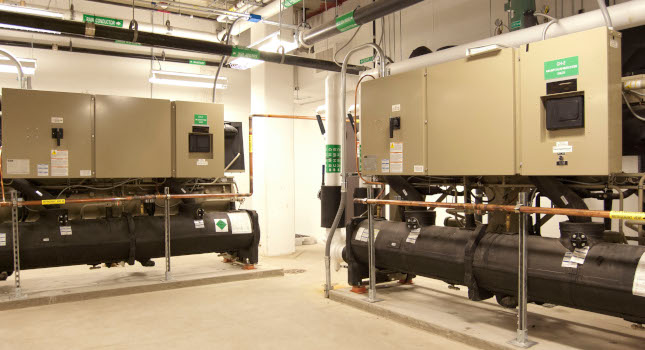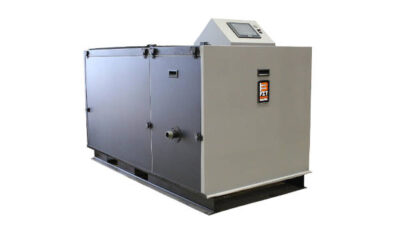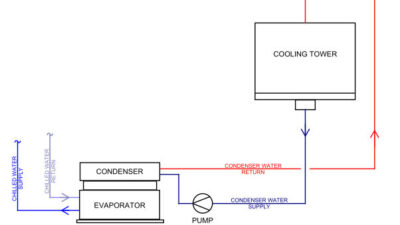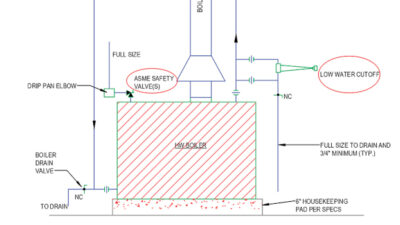Lowering the temperature of heating hot water systems is a key step toward decreasing energy used to heat buildings, and toward decarbonization and electrification

Learning Objectives
- Learn how low heating hot water temperature is critical to maximizing the efficiency of condensing gas boilers.
- Learn how low heating hot water temperature is critical to maximizing the efficiency of heat-producing refrigeration equipment.
- Learn steps that can be taken to allow heating hot water temperature to be lowered when designing a building’s hydronic heating system.
Hydronic system insights
- By lowering the heating temperature on boilers, water to water heat pumps, and heat recovery chillers, efficiency goals can be met.
- Lowering the heating temperature on water to water heat pumps and heat recovery chillers has a dramatic effect on their efficiency.
As buildings move toward decarbonization and electrification, it is increasingly important for engineers to incorporate lower heating water temperatures into the design of building hydronic heating systems to most efficiently apply both natural gas boilers and electric refrigeration machines as heating sources.
Early hydronic heating systems
Hydronic heating systems have been around for centuries, dating back to what is believed to be the earliest system in a 14th century Greenland monastery fed by a hot spring. Early fossil-fuel-heated hydronic systems relied on gravity circulation, with pumps not introduced until the early 20th century. Over time, hydronic heating systems, along with warm air, have supplanted steam and have become the predominant heating systems for buildings.
Modern hydronic heating systems provide occupants with a dependable, cost-effective and comfortable solution. Over the years, hydronic heating systems have evolved and engineers are continually developing new ways to increase efficiencies, integrate innovative technology, and reduce the impact on the environment.
Hydronic heating systems are commonly heated by a boiler that is fired by natural gas, with heating hot water circulated by pumps through a closed loop piping system. For many years, hydronic heating systems were designed with supply water temperatures commonly on the range of 180°F to 200°F, maximizing the output of hydronic heating devices while remaining safely below the system water boiling point. These high temperatures allowed heating devices such as air handling unit heating coils, zone air tempering coils, and perimeter heating devices to produce very ample heat for even the most demanding heating situations.

Introduction of condensing boiler technology
Over the past two decades, condensing natural gas boilers have become a popular choice among engineers and owners. Condensing boilers are significantly more efficient than noncondensing boilers because they extract more heat from the combusted fuel-to-air mixture by condensing the water vapor in the hot gases. To operate in the efficient condensing mode, condensing boilers require return water temperatures to be 130°F or lower (see Figure 2).
The lower return water temperatures required for the condensing mode limits the associated design supply water temperature to around 150°F to 170°F, in conjunction with hydronic heating device water temperature drops of 20°F to 40°F, respectively. While these 150°F to 170°F supply temperatures reduce the heating output of hydronic heating devices as compared to earlier 180°F to 200°F supply water, the effect is not dramatic, and a modest increase in heat transfer surface provides ample heat for even the most demanding heating situations. Mean water temperature for a hydronic heating device is equal to the average of the supply water temperature entering the device and the return water temperature leaving the device (see Figure 3).
With a hydronic heating system using condensing boilers, it is possible to still achieve high seasonal efficiency even if the hot water heating temperature is required to rise out of the condensing region (higher than 130°F return water temperature) only during the short periods of extreme cold outdoor conditions, and then is reset back down to the condensing region when outdoor conditions are not as extreme. This can be an important design approach when incorporating condensing boilers as a retrofit into an existing hydronic heating system designed originally to operate above 130°F return water temperature.

Introduction of refrigeration machines as heating sources
To take a further leap into decarbonization by moving into electrification, refrigeration machines such as air source heat pumps, ground source water-water heat pumps and heat recovery water chillers are now being used to generate heating hot water. Limiting the heating hot water temperature allows these refrigeration machines to be very efficient, all-electric heat producers.
Heating hot water temperature is a significant and limiting factor for the application of water-water heat pumps and water cooled heat recovery chillers. While there are chillers that can produce hotter water, for practical purposes the heating hot water temperature should be limited to no more than 140°F for standard machines using standard refrigerants. Even lower temperatures are desirable when possible.

This is because the efficiency of the heat recovery chiller is affected greatly by the “lift” at which the machine is operating, with lift being governed by the temperature difference between the cold fluid leaving the chiller’s evaporator and the hot fluid leaving the chiller’s condenser. In a heat recovery chiller, the fluid leaving the chiller’s condenser is heating hot water.
As demonstrated in Figure 4, lowering the lift of the heat recovery chiller by lowering the heating hot water temperature has a dramatic effect on the chiller’s coefficient of performance (COP); higher COP means higher efficiency and lower energy use.
For example, lowering the heat recovery chiller’s leaving water temperature from 140°F to 120°F can increase the chiller’s heating COP by 44% (see Figure 4).

How do hydronic systems do it?
For new construction and major renovations in a northern climate, engineers can target the heating, ventilation and air conditioning (HVAC) system’s hydronic heating devices to provide the required capacity at no greater than 120°F heating hot water supply temperature. This accommodates both the highly efficient condensing mode of operation in condensing gas boilers and high COP in heat pumps and heat recovery water chillers.
Designing with 120°F heating hot water supply temperature requires more rows and larger face area in airside heating coils. Due to the increased usage of these lower temperature hydronic heating systems, air terminal unit manufacturers have introduced options for units with coils having a larger face area — meaning more surface area for heat transfer — at a given airflow capacity.
Lower water temperatures require more finned element — more surface area for heat transfer — in finned tube radiators (see Figure 3). Additionally, designing with higher flow rates and therefore higher mean water temperatures at a given supply water temperature increases heating output. For example, lowering the mean water temperature in the example finned tube radiator from 170°F to 110°F lowers the heating output by approximately 65%.

Should the heating demand during extreme winter conditions exceed hydronic heating device capacity with 120°F heating hot water supply temperature, the supply water temperature from the condensing boilers and/or heat recovery chiller can be programmed to increase to accommodate the increased demand, with very modest impact on overall annual efficiency. As extreme outdoor conditions subside, the system supply water temperature can be programmed to decrease back to 120°F. Consideration must be given to the maximum heating hot water supply temperature capability if employing a heat recovery chiller, which is commonly 140°F for many machines.
Lowering the water temperature in hydronic heating systems can increase boiler efficiency to a significant extent when condensing natural gas boilers are installed, thus reducing a building’s carbon footprint. Lowering the water temperature also opens the door to the use of heat pumps and/or heat recovery chillers as efficient heat sources for the hydronic heating system, making these machines a smart choice for electrification.



